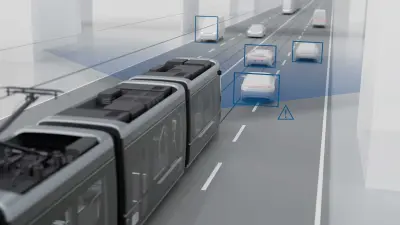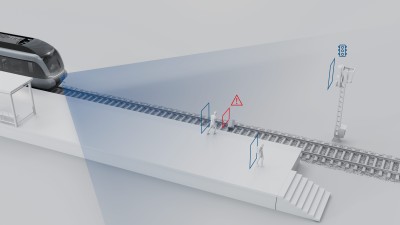Collision Warning System

For tram drivers, tough situations like heavy commuter traffic or poor visibility quickly become serious challenges. Obstacles on the rails or road users who approach the rails have to be detected in enough time for the risks to be recognized.
When it comes to its collision warning system for light rail vehicles, Bosch Engineering relies on proven components from automotive technology to actively reduce the expensive consequences of accidents or prevent them altogether.
improved safety
through avoiding collisions by means of early warning system

Loading the video requires your consent. If you agree by clicking on the Play icon, the video will load and data will be transmitted to Google as well as information will be accessed and stored by Google on your device. Google may be able to link these data or information with existing data.
high availability
of light rail vehicles: fewer accidents means less vehicle downtime

Task and Function
The collision warning system for trams supports drivers in critical situations. Especially in congested traffic or poor visibility conditions, the system warns the driver about obstacles on the rails in plenty of time. This lets drivers avoid accidents, or at least significantly limit the effects.
Consisting of a multi purpose camera, a radar sensor, and a control unit, the system monitors the track ahead and any possible obstacles in front of the vehicle in real time. If it detects a potential collision, it sends a warning to the driver. And should the driver respond too late or not at all, the collision warning system can initiate automatic braking.
lower cost
of repairs, since collision damage is considerably less or even absent altogether
Detecting critical situations
The multi purpose camera monitors the track ahead and transmits the data in real time to the radar sensor. Independent of weather and light conditions, the radar sensor recognizes potential obstacles in front of the vehicle from a distance of up to 80 meters away. Taking the vehicle’s speed into consideration, the system uses the information to determine the danger of a collision.

In type 1 of the system, it determines whether the threat presented by an obstacle warrants a visual and/or acoustic warning to the driver. Type 2 of the system offers a further function: it sends a signal via relay output to trigger automatic braking, should the driver respond too late or not at all to the system’s warning.

simple integration
thanks to compact components






